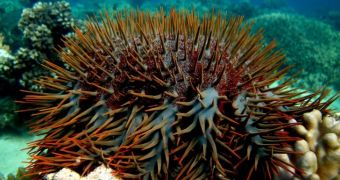Australia is happy to announce that, over the past 21 months, it has killed about 250,00 crown-of-thorns starfish. The country claims that, in doing so, it has managed to protect a large portion of the Great Barrier Reef.
Wildlife researchers explain that, in recent years, the crown-of-thorns starfish population in the proximity of the Great Barrier Reef has upped to a considerable extent.
Evidence at hand indicates that this is due to environmental pollution. Thus, said marine creatures are believed to have thrived as a result of chemical runoff from agriculture, The Guardian informs.
More precisely, crown-of-thorns starfish are believed to feed on whatever nutrients work their way into aquatic ecosystems after being used in agricultural practices on lands close to the Great Barrier Reef.
Specialists explain that, although the Great Barrier Reef has been home to crown-of-thorns starfish for many decades now, the problem is that these creatures tend to snack on corals. Hence, having too many of them around is bound to upset this ecosystem.
Scientists with the Australian Institute of Marine Science detail that, first off, this species of starfish constitutes a threat to the Great Barrier Reef due to the fact that they do not shy away from feeding on healthy corals.
What's more, information indicates that, of the 50% loss in coral cover that said ecosystem has experienced over the past three decades, an impressive 42% need be attributed to crown-of-horns infestation, the folks at the Australian Institute of Marine Science detail.
Information shared with the public says that, in order to kill such starfish, divers inject them with compounds that cause them to develop an allergic reaction and consequently die. This method is the brainchild of researchers at James Cook University
By the looks of it, this method is way more efficient than previous ones, which involved injecting the coral-killing starfish up to 20 times before the marine creatures eventually passed away.
It is said that, thanks to the efficiency of the cocktail of chemicals developed by the James Cook University specialists, divers can now cull over 1,000 crown-of-thorns starfish during a 40-minute dive. Thus, the rate of removal over the past 21 months has been found to be four times greater than the one documented before the implementation of this new method.
Thanks to the recent success of the crown-of-thorns starfish cull in the waters around the Great Barrier Reef, it was in last year's December that the Australian government provided an additional $1.1 million (about €0.79 million) in funding for this initiative. The money was used to purchase a new vessel that was supposed to be used by divers entrusted with tracking down and killing these marine mammals.

 14 DAY TRIAL //
14 DAY TRIAL //